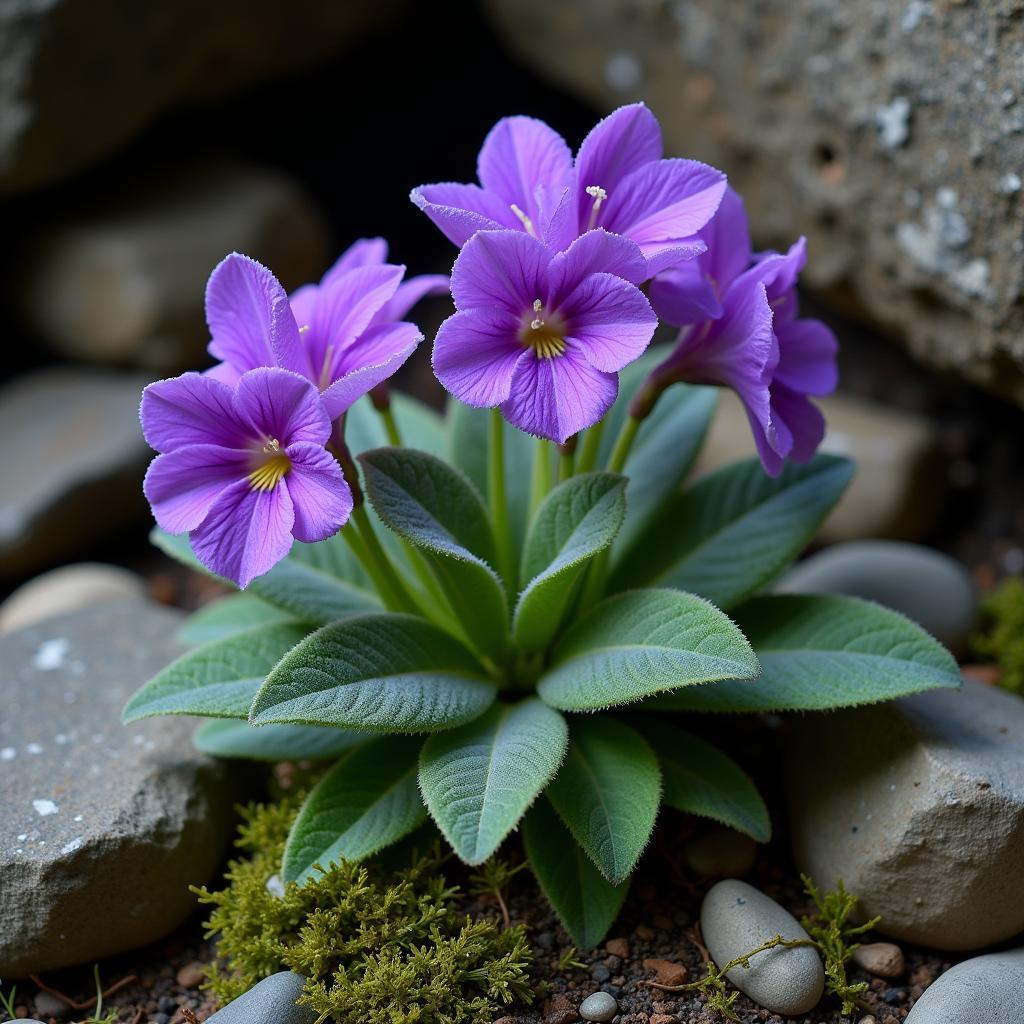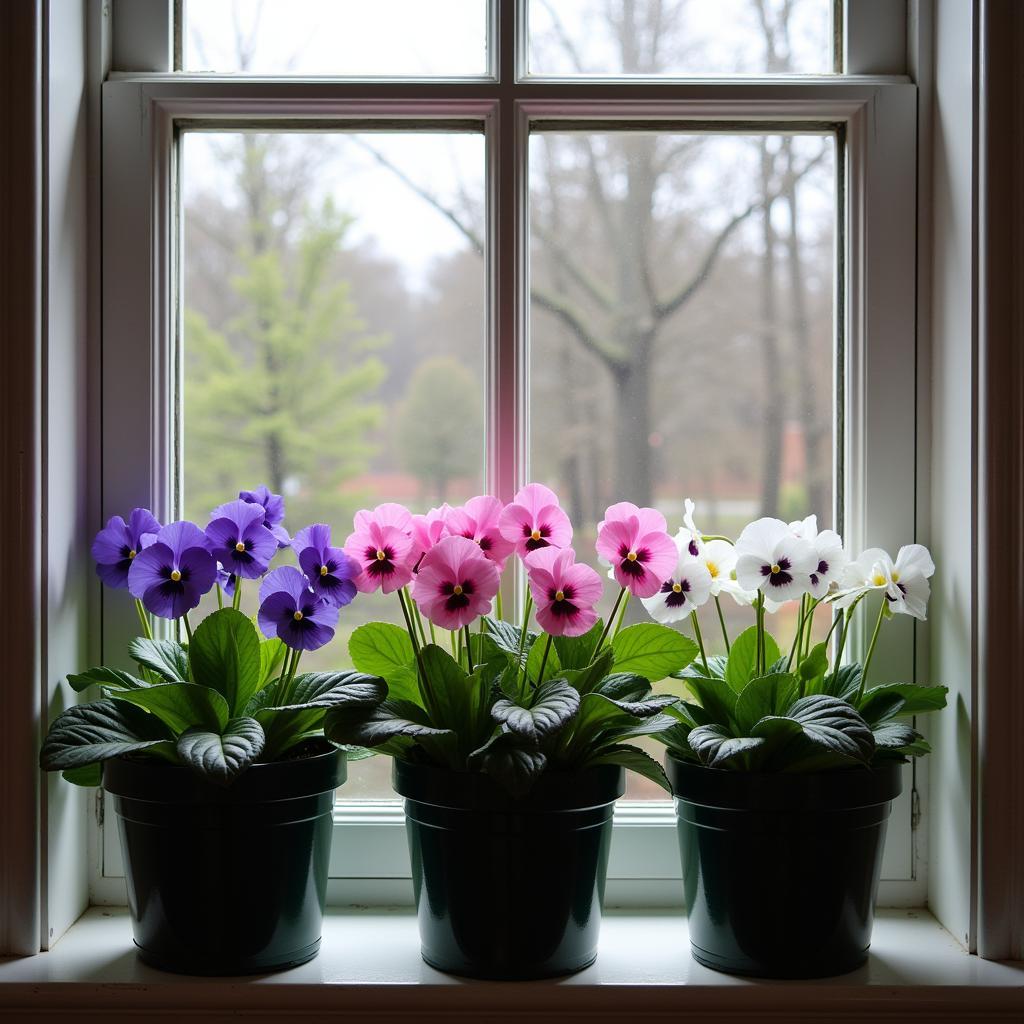The African Violet Plant, with its delicate blooms and velvety leaves, is a beloved houseplant cherished for its beauty and ease of care. Native to the tropical regions of East Africa, particularly Tanzania and Kenya, this flowering gem has captured the hearts of plant enthusiasts worldwide.
A Tanzanian Treasure: Exploring the Origins of the African Violet
The story of the African violet’s journey from the rainforests of East Africa to windowsills across the globe is as fascinating as the plant itself. In 1892, Baron Walter von Saint Paul-Illaire, a German colonial official stationed in Tanzania, stumbled upon this captivating plant while exploring the Usambara Mountains. Intrigued by its vibrant violet flowers and soft, fuzzy leaves, he sent seeds back to his father in Germany, igniting the plant’s popularity in Europe.
 African violet plant thriving in its natural habitat
African violet plant thriving in its natural habitat
African Violet Care: A Guide to Happy Blooms
Despite their delicate appearance, African violets are surprisingly resilient and adaptable to indoor conditions. With proper care, these charming plants can thrive and grace your home with a continuous display of blossoms.
Light: The Key to Vibrant Blooms
African violets crave bright, indirect light. Avoid placing them in direct sunlight, as this can scorch their delicate leaves. East-facing windows are ideal, providing gentle morning sun.
Watering: A Balancing Act
Overwatering is a common pitfall for African violet owners. These plants prefer their soil to be slightly moist but never soggy. Water when the top inch of soil feels dry to the touch, and always use lukewarm water to avoid shocking the roots.
Humidity: Recreating the Tropics Indoors
Hailing from humid rainforests, African violets appreciate a touch of extra moisture in the air. Grouping them with other plants, using a humidifier, or placing them on a tray filled with pebbles and water can help increase humidity levels around the plant.
Fertilizing: Nourishing Abundant Blooms
To support their prolific flowering, African violets benefit from regular fertilization. Use a balanced, water-soluble fertilizer specifically formulated for African violets and feed them every two weeks during the growing season (spring and summer).
Troubleshooting Common African Violet Issues
Even with the best care, African violets can sometimes encounter issues. Here are some common problems and solutions:
- Yellowing Leaves: Often a sign of overwatering or cold drafts. Check the soil moisture and relocate the plant to a warmer spot.
- Brown Spots on Leaves: Usually caused by cold water or direct sunlight. Use lukewarm water for watering and provide bright, indirect light.
- Lack of Blooms: Insufficient light or improper fertilization can hinder blooming. Ensure the plant receives adequate light and fertilize regularly during the growing season.
Beyond the Classic Purple: Exploring African Violet Varieties
While the classic purple African violet remains a favorite, these versatile plants come in a dazzling array of colors and flower forms. From delicate pinks and whites to vibrant reds and blues, there’s an African violet to suit every taste.
The Charm of Miniature African Violets
For those with limited space, miniature African violets offer the same beauty and charm in a more compact form. These petite plants thrive in small pots and make delightful additions to terrariums or tabletop displays.
 A collection of African violet plants showcasing different colors and flower forms
A collection of African violet plants showcasing different colors and flower forms
Conclusion: Welcoming the African Violet into Your Home
The African violet plant, with its captivating beauty and easy-going nature, is a rewarding addition to any home. By understanding its basic needs and providing proper care, you can enjoy a continuous display of its charming blooms. Whether you’re a seasoned plant enthusiast or a beginner looking for a low-maintenance yet rewarding houseplant, the African violet is an excellent choice.
FAQs
1. How often should I repot my African violet?
Repot your African violet every 12-18 months or when you notice roots circling the bottom of the pot. Use a well-draining potting mix specifically designed for African violets.
2. Can I propagate African violets from leaf cuttings?
Yes, African violets are easily propagated from leaf cuttings. Simply snip a healthy leaf with its stalk intact, insert it into a moist rooting medium, and provide warmth and humidity.
3. Why are the leaves on my African violet curling?
Leaf curling can be a sign of several issues, including underwatering, low humidity, or pests. Check the soil moisture, increase humidity levels, and inspect the plant for any signs of insects.
4. How long do African violets typically live?
With proper care, African violets can live for many years, even decades. Consistent care, proper lighting, and regular repotting contribute to their longevity.
5. What are some good companion plants for African violets?
Good companion plants for African violets include other humidity-loving species like ferns, peace lilies, and prayer plants.
Need More Assistance?
For any further inquiries or assistance with your African violet plant, please do not hesitate to contact us. Our team of plant experts is available 24/7 to provide personalized guidance and support. Reach us at:
Phone Number: +255768904061
Email: [email protected]
Address: Mbarali DC Mawindi, Kangaga, Tanzania
We are always delighted to help you cultivate a thriving indoor garden. For more insights on African flora, explore our articles on African flowering plants and African hanging leaves.
Leave a Reply